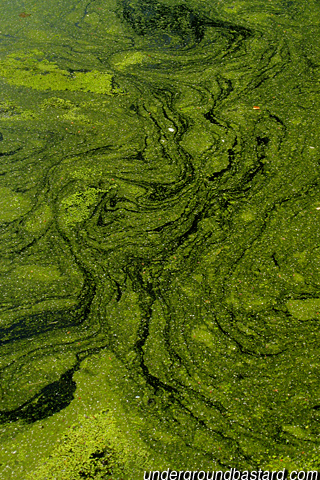Disclaimer: It's dangerous when I get a little time to think.
I covered assumptions and adjustments back in Emptying Your Hypothetical Box, but we'll be diving a little deeper into Adjustment #2 here. I was thinking in the car at far-too-early AM this morning when the GM Paradigm for Schrödinger's Gun hit me.
 |
| It's all about the Ooze. |
What if you frame the GM's role using a larger scope? Try this:
A GM's job isn't about controlling the game world. It's about controlling the Primordial Ooze during play, that pile of raw creative stuff from which the game world is formed.
I can hear some of you saying, "But isn't that the game designer's job?" And you're absolutely right to a point. The game designer shapes the Primordial Ooze into the tools with which the GM and the players make the story of their game. But a toolkit doesn't contain a story, it contains the potential for many stories, each one scooped out of the Ooze and shaped by the GM and players using the provided tools. Even prepared settings only provide the backdrop for the story that the players around your table tell.
It makes no difference if the game designer produces thousands of task-specific tools, or a few flexible multitaskers, gamers can build stories using nearly anything. Personal preference colors opinions about which toolkit works better, but that discussion has no place here since we're talking about methods of GMing and not system specificity.
With this idea in mind, you can use the Ooze to make a game world for your players to explore and discover what you've created as is usually done by GMs in traditional systems. Alternately, you can decide to delegate some of your control and let your players get their hands all Oozy creating things, even during the course of play. This approach frees up options for you as GM, and it lets you spend more time on readying yourself to effectively react to whatever the players throw at you. As a GM using this paradigm, you become a producer making sure the whole story gets born far more than a director who focuses on moving characters around and the smaller details of the current scene.
 |
| Just add water. Or better yet, creative intent. |
For more on this idea of reactive vs. proactive players, check out Rob Donoghue's exploration back in August: Moving Pieces over at Some Space To Think. It's a great read and a great framework for thinking about play style. And for the record, when I think about Schrödinger's Gun GMing, I'm thinking about a system to more easily tackle play in the upper right corner of the chart, though I hope some techniques work in other quadrants as well.
Have you given your players any Primordial Ooze to shape in their character's image? Did you give them creative control over a group? A town? A country? An entire race? How did it work at your table?
Thanks for reading!
Go to the Schrödinger's Gun GMing Cover Page.

I've long made it a point to incorporate player ideas as much as possible, but I've always held a lot back, to enable the ideas I had about the adventure, the plan I had for it.
ReplyDeleteLast week, I decided to do a completely collaborative session and see how well that worked. The PCs had previously landed on the outskirts of a drow city, so that we could start The Demon Queen's Enclave. I had already planned on changing much about the module, but what I realized is that I had no idea if the players would be the least bit interested in what I had planned, or even in the module as written. I had no clear path to proceed. Hence the decision to collaborate with them.
The session worked very well. Very few dice were rolled, but that was mainly a side effect of time and the fact that they adroitly avoided any full combat. Together we came up with the look of the city, including the slums where non-drow live, a bit about the sewage system, and ideas about the society. Everyone contributed and I feel that everyone is much more invested in the setting and the adventure at this point than if I had just shown them pictures and read boxed text, or tried to go with something made entirely by me.
We're going to continue in this mode for a while. The big challenge is combat. So far the group has defused all the combat they might have encountered, yet the players are still interested in having combat. So, getting them to that point, and then collaborating to make combat interesting, will be an interesting project.